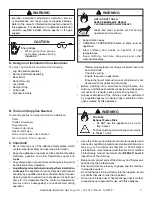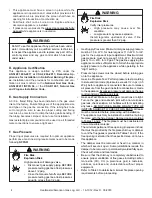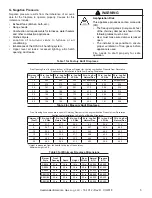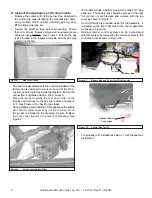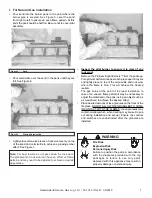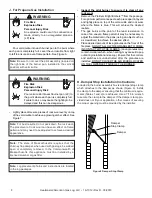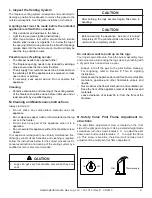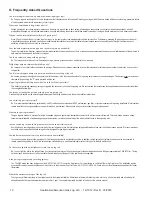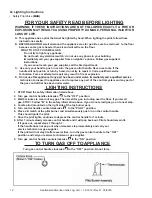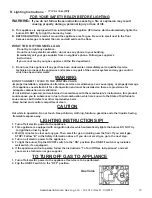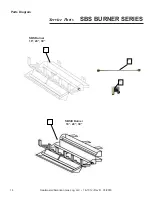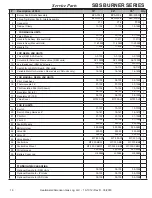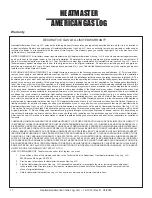
Heatmaster/American Gas Log, LLC • 16-1012 •Rev D. 03/2018
4
D. Appliance Certification
This appliance is design certified by PFS under the
ANSI Z21.60b-2017 or CSA 2.26b-2017, Decorative Ap-
pliances for Installation in Solid-fuel Burning Fireplac-
es.
Installation and the provisions for combustion and ven-
tilation air must conform to the
National Fuel Gas Code,
ANSI Z223.1/NFPA 54
, or the
CSA B149.1, Natural Gas
and Propane Installation Code.
•
This appliance must have a screen in place while the
appliance is in operation and, unless other provisions for
combustion air are provided, the screen shall have an
opening for introduction of combustion air.
• Solid fuels shall not be burned in a fireplace where a
decorative appliance is installed.
• If glass doors are present, the
glass doors must be fully
opened
while appliance is in operation.
Do NOT use this appliance if any part has been under
water. Immediately call a qualified service technician
to inspect the appliance and to replace any part of the
control system and any gas control which has been
under water.
WARNING
E. Gas Supply Connection
A 3/8 in. flared fitting has been installed on the gas valve
inlet at the factory. Ensure fittings are of the appropriate size
and type on the gas line connection. If the tubing has to be
cut to length be sure to use the proper cutting and flaring
tool. Also, be careful not to crimp the tubing while bending. If
the tubing becomes crimped, do not use for installation.
Gas resistant pipe compound must be used on all threaded
male connections to ensure a tight seal.
F. Gas Pressure
Proper input pressures are required for optimum appliance
performance. Gas line sizing requirements need to be made
following
NFPA51
.
Fire Risk
Explosion Risk
Verify inlet pressures.
• High pressure may cause over fire
condition.
• Low pressure may cause explosion.
Install regulator upstream of valve if line
pressure is greater than 1/2 psig.
WARNING
Fire Risk
Explosion Risk
High pressure will damage valve.
• Disconnect gas supply piping BEFORE
pressure testing gas line at test pressures
above 1/2 psig.
• Close the manual shutoff valve BEFORE
pressure testing gas line at test pressures
equal to or less than 1/2 psig.
WARNING
• Gas Supply Pressure: Minimum inlet gas supply pressure
must be 7.0 in. W.C. for natural gas or 11 in. W.C. for LP
gas for the purpose of input adjustment. Maximum inlet
gas pressure must not exceed 10.5 in. W.C. for natural
gas or 13 in. W.C. for LP gas. The gas line supplying the
appliance must be sufficient size to furnish the appropriate
supply pressure to the appliance while operating in the
“High” setting.
• Pressure tap screws must be closed before turning gas
on to the appliance.
• Gas Line Pressure Test: Perform pressure test according
to state and local code (if pressure exceeds 1/2 in. psi (3.5
kPa)) before appliance is connected. Be sure to release
air pressure from the gas line before connection is made
to the appliance. Excessive pressure will damage the gas
control and may cause a gas leak.
• Gas Leak Test: Make sure the gas connections are tight.
Turn on the gas and coat each joint with a non-corrosive
gas leak check solution. Air bubbles will form indicating
any leaks. DO NOT USE A FLAME OR ANY TYPE OF
IGNITION SOURCE TO CHECK FOR LEAKS. All leaks
must be corrected before proceeding with installation.
• The appliance must only be installed in a solid-fuel burning
fireplace with the flue damper clamped open according
to Tables 1 and 2. The fireplace must be constructed of
non-combustible material.
• The minimum permanent free opening (in square inches)
that must be provided by the fireplace chimney or damper
to vent the flue gases is provided in Tables 1 and 2. If the
free opening is smaller than the specified area, do not use
this appliance.
• The damper must be removed or fixed in a manner in
which will secure it open. Some jurisdictions require the
damper to be removed or permanently welded fully open.
Check with state and local codes.
• Be sure that the chimney is completely unobstructed to
ensure proper ventilation of flue gases including carbon
monoxide (CO). CO (a poisonous gas) is tasteless,
odorless, colorless and undetectable without proper
equipment.
• Refer to Table 3 to determine minimum fireplace opening
requirements before proceeding.



